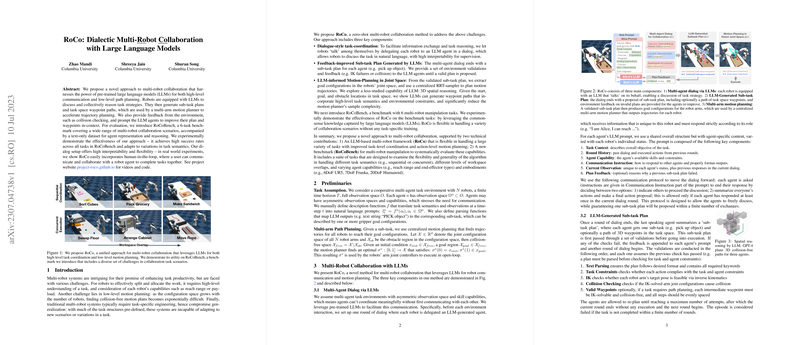Dialectic Multi-Robot Collaboration with LLMs
The research presented in "RoCo: Dialectic Multi-Robot Collaboration with LLMs" by Zhao Mandi, Shreeya Jain, and Shuran Song proposes a novel approach to multi-robot collaboration. This methodology employs LLMs for coordinating task strategies and planning motion trajectories in a zero-shot setting. Given the increasing complexity of tasks requiring multi-robot systems, this approach aims to enhance both high-level strategy formation and low-level trajectory planning, addressing limitations traditional systems face in adaptability and generalization.
Methodological Advancements
The paper introduces a multi-faceted approach centered on integrating LLMs into multi-robot systems:
- Dialogue-Based Coordination: Each robot is equipped with an LLM agent, allowing for natural language dialogues to coordinate tasks. This involves the exchange of high-level strategies via a structured dialogue, reflecting each robot’s capabilities and task contexts. The dialogue-based coordination purportedly enhances interpretability and facilitates human-over-the-loop monitoring.
- Feedback-Driven Sub-Task Planning: LLM agents collaboratively generate sub-task plans, which are iteratively refined based on feedback from environmental interaction checks, such as inverse kinematics (IK) and collision avoidance results. This iterative feedback loop is posited to improve both the feasibility and safety of the generated plans.
- LLM-Informed Motion Planning: Transitioning from validated sub-task plans, the methodology uses LLMs for generating motion waypoint paths that inform joint spaces for motion planning. The capability of LLMs to handle 3D spatial reasoning offers potential reductions in sampling complexity during path planning.
Experimental Results
The introduction of RoCoBench, a 6-task benchmark crafted to evaluate the proposed approach's efficacy across diverse multi-robot collaboration scenarios, supports this research’s evaluative claims. Notably, RoCo demonstrates high success rates across all tasks with appreciable adaptability to semantic variations, indicating the robustness and flexibility of LLM-driven coordination strategies.
The results also reveal intriguing insights into the practical capabilities of LLMs in non-traditional roles, such as 3D path planning, and highlight the effectiveness of dialogue-driven task planning over centralized planning schemes in dynamic environments. The evaluation metrics focus on success rates, task completion efficiency, and adaptability to environmental feedback, thereby confirming the potential of RoCo in real-world task scenarios.
Implications and Future Directions
The implications of this research extend to both theoretical advancements and practical applications. Theoretically, it introduces novel intersections between natural language processing and embodied AI systems, leveraging LLMs for tasks traditionally dominated by explicit task-engineered solutions. Practically, the success of RoCo can inspire broader adoption of LLMs in robotics, particularly for tasks involving dynamic environments and unstructured interactions.
Future research may explore enhancements in LLM model efficiencies specific to robotic applications, adaptations for real-time tasks, or integrative frameworks that combine LLMs with computer vision models for autonomous task perception and execution in dynamic real-world contexts. Further investigation into addressing limitations observed in open-loop execution and perceptual inaccuracies may also significantly enhance practical applications.
In summary, this paper contributes a robust framework that significantly advances multi-robot collaboration using state-of-the-art LLMs, paving the way for future exploration and integration of language and planning in intelligent robotic systems.
